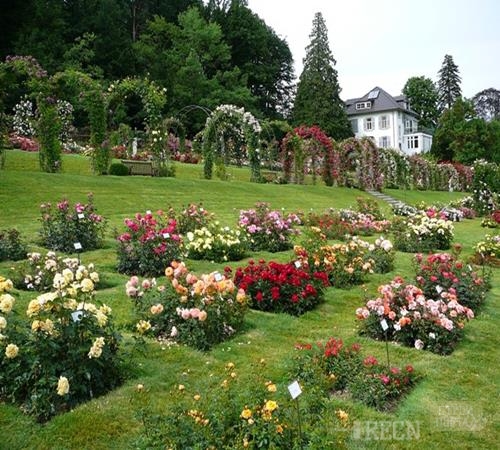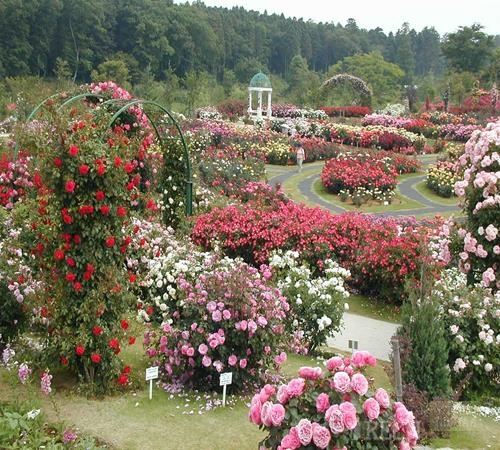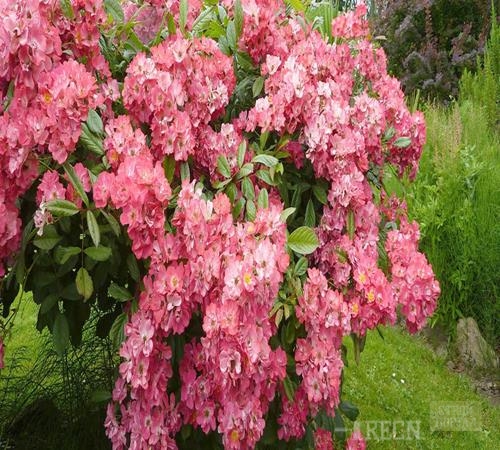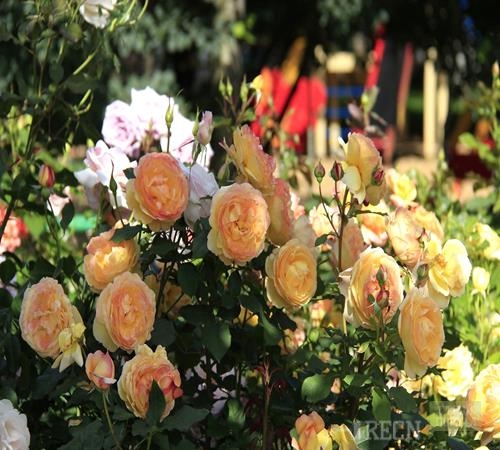
How to make a rosary with your own hands Plot.
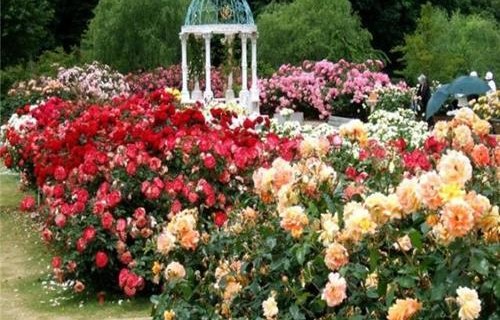
Imagine a cottage or a country cottage without flowers on the flower beds around the house and simply impossible on the adjacent area, because they allow you to create a festive and joyful mood even on weekdays.
Content
One of the most original colors includes a rose, the varieties of which are very different both in the height of the stem and the color of petals. To roses look most effectively, turning the household plot into a real corner of the wildlife, it is worth thinking about breaking the rosary in the garden or near the house.
Selection of space for rosary
Before you begin to create a rosary, you need to carefully examine the entire territory around the house and stay at the site with the most good illumination. Roses - truly light-minded plants, so for their successful growth, the sun in the place where they grow should be a lot. If you put the pink bushes in the shade, the risk is the risk that the colors stems spawn due to the fact that they will constantly reach the sun. At the same time, the entire shrub will look at one-sided and ugly.
When choosing a place for the rosary, it is recommended to give preference to the southern side of the site, where the intensity of the light flux is ideal for growing roses. However, one should not forget that the rosary in the country should be maximally protected from wind and drafts, since these flowers are very sensitive to them. On the other hand, a plot where the sun takes up from early morning to late evening, it is hardly suitable for a suitable. Optimal conditions for growing roses - a combination of a half and a large amount of the sun. The location is ideal for which the sun shines up to 12 and after 15 hours of the day, and in the time interval from 12 to 15 it is in a half.
There are other features of the selection of space for the site:
- If the soil is clay, before planting colors it is necessary to add sand or peat.
- If possible, it is necessary to give preference to a drainaged loamy and sampling soil, which has good fertility. The optimal level of acidity (pH) is 5-6 units.
- It is not necessary to consider as a place for a rosary plots on which groundwater flows at a depth of less than 2 meters. This increases the risk of high humidity or soil fever, and this most often leads to the death of plants.
It is best to create a rosary in the area of \u200b\u200bthe arbor, a parisader, recreation areas, either near the terrace, where the shadow does not fall from buildings and high trees. The zone in front of the front entrance is not a very good choice, since in the fall and spring rose it will be necessary to cover with a loan, rubberoid or sweetheart, so flowerba will look not too impressive. The soil is recommended to prepare the soil before planning the colors, making organic fertilizers.
Preparation of a rosary site also includes a complete removal of weeds, so the selected area is advisable to rinse in the fall, six months before the spring pore, when the seed landing begins.
Drawing up a Rosary scheme
Any rosary, photo of which is shown in this article, is not planted as it fell, but according to certain laws of the composition. First of all, you need to choose a color gamut for a future flower garden. Two options are possible:
- Rosary, designed in a romantic style, which prevails gentle pastel shades (white, lilac, pink).
- Rosary in bright colors with the dominance of yellow, orange, red.
But in the event that I want something unusual and even a little extravagant, make a contrasting rosary with your own hands, in which it harmoniously coexist, for example, white, red and purple flowers.
Thinking out the arrangement of colors in rosary, it is preferable to plant them so that roses of cheerful red, yellow and burgundy shades alternated with pink and white flowers. This makes it possible to create a slim harmonious composition that will look even more magnificent if its motley stressed by the flower bed planted on the perimeter evergreen shrubs or perennial plants. Ferns and conifers will not only serve as the optimal background for emphasizing the beauty of the flower bed, but also help to provide the painting of this corner after the roses are swinging.
If the experience in the arrangement of flower beds is insignificant, then invaluable help will have a rosary scheme that significantly reduces the costs of time and labor on its landing. It is clearly marked by zones in which flowers will be planted with various varieties. At the moment, two types of planning rosary are popular:
- Landscape. It is welcomed by an arbitrary flow of a flower garden, so it looks less officially. Therefore, landscaped layout is designed for small sections and leaves the feeling that roses grow in this place by itself, naturally, and not specifically planted by someone. This gives a rosary special airiness and ease.
- Regular. It is ideal for sections of a significant area located on well-visible places of the local area. Regular layout involves planting roses or other colors in areas limited by any coating: stones, plates, pebbles, broken bricks. A characteristic feature of such a rosary will be a strict geometric shape (square, oval, rectangle, triangle). It will organically fit both lonely bush and a group planting of plants of the same type. Most often by the framing of the rosary of this kind serve blue ate, fir, juniper and other coniferous plants. If the flower garden is broken by the wall, arches or gazebos, it includes curly roses, which will be supported for old trees and specially installed arcoid supports.
The rosary scheme takes into account all the nuances of a particular nuclear area. In the flower bed, which one side is adjacent to the fence, it is advisable in the background to plant roses with lower stems, and there are ahead of the lowest varieties, among which one or two bushes of medium height or plenty roses are interesting.
Selection of colors for rosary
If a large area is highlighted under the rosary, then there are no obstacles to landing in it tall pleethy, parking, ordinary tea roses. Typically, such plants are wide and grow strongly in height (sometimes 1.5 m). Therefore, in the case of a small territory, they should prefer the varieties of compact, tea, burgundy, polyanth roses, as well as roses Floribunda.
Of course, the main part of the rosary, as follows from the name, make up roses, but also to sit next to them with other flowers is quite acceptable. The magnificence of roses bushes is emphasized by irises, cloves, catnik, lavender, melluccic plants, peonies, tulips, forget-me-not, and in color they do not have to be combined with dominant in flower beds. There are certain rules for landing "neighbors" of roses:
- Red roses are well filled with lilac, yellow, bright pink purple flowers.
- Yellow roses perfectly feel in combination of plants, blooming cream, apricot, salmon or peach color.
- The choice of plants surrounding white roses will be correct if the shade of their petals is gentle pink, cream or peach.
Order of work on the arrangement of the rosary
Since the flower garden is not the most complex element of the arrangement of the household site, it will be quite relevant to discuss how to make a rosary independently. Flowers are planted in it only in the spring after weeding the site, allowing to remove weeds and its fertilizers from it. The organic fertilizers for roses include compost, humus, peat overwhelmed manure. Mineral fertilizers can be prepared. At the rate of the Cube meter, it is necessary to take 20 g of potassium chloride, 70 g of superphosphate and 30 g of ammonium nitrate.
Among the necessary tools and materials are cuttings of plants, shovel, clamzit, peat. Then we perform the following work algorithm:
- They dig up the pits whose depth cannot be less than 50-60 cm. If the groundwater flows in the ground very close from its surface (the distance from them to the top layer of the soil is less than one and a half meters), additional drainage should be installed. To do this, we fall asleep in the pit of gravel or clamzite, we will be tamped, add peat and sand.
- Moisten the root system of colors, we remove the broken ends and shorten the above-ground part of the plant. Thus, there are 1-3 most viable processes in which there are no leaves, flowers and shoots.
- We take out a flower bush from the container and planted into one of the landing holes, while controlling the correctness of the location of roses. The lowest varieties should be on the front line, colors with a middle height stem - on the midline, and the plenty roses generally play the background, located in the background.
- During the landing, keep the rose stalk strictly vertically, checking the ends of the roots not covered up. To prevent this, periodically shake the cutter, which contributes to the uniform distribution of the planting mixture, fully filling the space between the root process.
- A little closer to the land near the bush of the legs, then again we break slightly, we water intensely and add a peat layer or sawdust, a height of approximately 20 cm.
Rose planting density is 2-3 m - for curly, mobble stamps and tall park roses, 1.5-2 m - for slowly growing rolling varieties and strambl roses, 60-100 cm - for low parking and tea-hybrid roses, 25 -50 cm - for roses Floribunda.
Stambling rose landing has its own nuances:
- The well for them makes exactly the size of the rhizoma, and so that the strambette plant does not break from the wind, you instress a wooden peg at a distance of 10 cm from it, from a leeward side, and tie a rose barrel to it. The diameter of the casson is 2-4 cm, and the height corresponds to the height of the strab rose plus an additional 50-70 cm.
- The underground part of the carriage is processed by an antiseptic to prevent the wood rotting, and immersed in the pit, dugged for roses, to a depth of 50 cm.
- The rope for the garter of the strambered tree must be squeezed, after which it is fixed on the plant, in the form of a 8-shaped loop: in the earth, in the middle of the trunk and where the crown begins. To prevent damage to the plant, in places where the loops should be wrapped in burlap.
Decorative functions Rosary
The rosary is wonderfully combined with other elements of the decor on the plot. So, it is good to do it by the pool with inner illumination, because in the evening the flowers in the lack of lighting from under the thickness of the water will look very romantic. If the flower beds are dominated by roses of non-lass shades, an additional bucket of the residential area will give a small bench or a coffee table near the rosary. High and lush flower bushes allow even if the landing geometry is observed to create a similarity of an improvised room with walls.
Curly roses are very organically look at arches or columns. If there are no such elements of the decor, you can simply bury several wooden pillars connected by chains or thick ropes, along which roses should be allowed.
The lower part of the pink bushes is not always a aesthetic sight, so this deficiency is often masked by a border. It uses a fencing from low-layer plants. Plants such as Santolina Cypress, Sangeit, Lavender, Sea Cineurial, Woolly, Having Green or Silver Leaves are suitable for a rosary of a roseantic style. If the flower garden pleases the eye with a bright and rich color range, to optimally use the Tunberg Barberrysta as an improvised fence, the arrest of burgundy or rosemary and rosemary. With a sufficient area of \u200b\u200bthe site and especially its uneven relief, it is recommended to make a rosary with terraces, where the tallest plants will be on the lower ledge, and the lowered - on the upper "floors".




